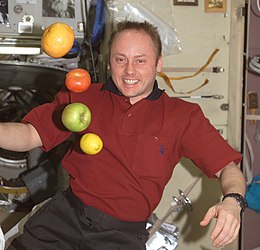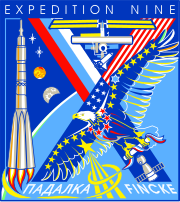Expedition 9
 Edward M. (Mike) Fincke, Expedition 9 NASA ISS science officer and flight engineer, is pictured near fresh fruit floating freely in the Zvezda Service Module of the International Space Station. | ||
| Mission type | ISS Expedition | |
|---|---|---|
| Mission duration | 185 days, 15 hours, 7 minutes (at ISS) 187 days, 21 hours, 16 minutes (launch to landing) | |
| Distance travelled | ~121,802,083 kilometres (75,684,306 mi) | |
| Orbits completed | 2,940 | |
| Expedition | ||
| Space station | International Space Station | |
| Began | 21 April 2004, 05:01 UTC[1] | |
| Ended | 23 October 2004, 20:08 UTC[2] | |
| Arrived aboard | Soyuz TMA-4 | |
| Departed aboard | Soyuz TMA-4 | |
| Crew | ||
| Crew size | 2 | |
| Members | EVA duration | 15 hours, 45 minutes |
 Expedition 9 mission patch | ||
Expedition 9 (2004) was the ninth expedition to the International Space Station[3] (21 April 2004[1] – 23 October 2004).[2]
Crew

| Position | Astronaut | |
|---|---|---|
| Commander | RSA Second spaceflight | |
| Flight Engineer 1 | First spaceflight | |
| Position | Astronaut | |
|---|---|---|
| Commander | Fourth spaceflight | |
| Flight Engineer 1 | RSA Second spaceflight | |
Planned crew before Columbia disaster
| Position | Astronaut | |
|---|---|---|
| Commander | RSA
| |
| Flight Engineer 1 | ||
| Flight Engineer 2 | RSA
| |
Mission parameters
- Perigee: 384 km
- Apogee: 396 km
- Inclination: 51.6°
- Period: 92 min
Mission objectives
Padalka and Fincke arrived at the Station on 21 April 2004 aboard the Soyuz TMA-4 spacecraft with European Space Agency (ESA) Astronaut André Kuipers.[1] After more than a week of joint operations and handover activities, Padalka and Fincke officially took command of the Station on 29 April when Expedition 8 Commander Michael Foale and Flight Engineer Alexander Kaleri left the Station.[6] This mission was the site for the Advanced Diagnostic Ultrasound in Microgravity Project.[7]
Expedition 8 and Kuipers returned to Earth that same day aboard the Soyuz TMA-3 spacecraft. Kuipers' 11-day mission to the ISS was part of a commercial agreement between ESA and the Federal Space Agency of Russia.
Spacewalks
The Expedition 9 crew conducted four spacewalks during its stay at the International Space Station. The four spacewalks were devoted to ISS maintenance and assembly. All four were based out of the Pirs Docking Compartment and used Russian Orlan spacesuits.
Before these four extravehicular activities (EVAs), 52 spacewalks had been performed at the ISS, with 27 based out of the Station.
Gennady Padalka (EV1): red stripes Mike Fincke (EV2): blue stripes
| Mission | Spacewalkers | Start (UTC) | End (UTC) | Duration |
|---|---|---|---|---|
| Expedition 9 EVA 1[8] |
Mike Fincke
|
24 June 2004 21:56 |
24 June 2004 22:10 |
14 minutes |
| The spacewalk was cut short due to a pressure problem in Fincke's prime oxygen tank in his spacesuit. Mission managers decided to reschedule the spacewalk for 29 June. | ||||
| Expedition 9 EVA 2[9] |
Mike Fincke
|
29 June 2004 21:19 |
30 June 2004 02:59 |
5 hours 40 minutes |
| Padalka and Fincke replaced a Remote Power Controller (RPCM) that failed in late April, causing a loss of power in Control Moment Gyroscope No. 2 (CMG 2). A failed Remote Power Controller Module was responsible for the temporary loss of CMG 2 in April. The gyroscope is one of four that control the ISS' orientation. | ||||
| Expedition 9 EVA 3[10] |
Mike Fincke
|
3 August 2004 06:58 |
3 August 2004 11:28 |
4 hours 30 minutes |
| In preparation for the arrival of the European Space Agency's Automated Transfer Vehicle (ATV), Padalka and Fincke removed laser retro reflectors from the Zvezda Service Module assembly compartment and installed three updated laser retro reflectors and one internal videometer target. They installed two antennas.
The spacewalkers removed Kromka Panel No. 2 and installed Kromka Panel No. 3. The Kromka experiment exposes various materials to the space environment. They also replaced another materials science experiment. | ||||
| Expedition 9 EVA 4[11] |
Mike Fincke
|
3 September 2004 16:43 |
3 September 2004 22:04 |
5 hours 20 minutes |
| Expedition 9's fourth scheduled EVA prepared the Station for future assembly operations and the arrival of the ATV. The spacewalkers replaced the Zarya Control Module flow control panel and installed four safety tether fairleads on Zarya's handrails.
ATV support operations included installing equipment for the air-to-air radio link antennas and removing all covers from antennas. Other tasks included installing a Pressure Control and Exposure Monitor Sensor on Pirs and installing protective components on the brackets of Pirs' ring handrails on EVA Hatch No. 2. | ||||
Mission patch
The design of the Expedition 9 mission patch includes a tribute to astronauts and cosmonauts who gave their lives in space exploration.
References
![]() This article incorporates public domain material from websites or documents of the
This article incorporates public domain material from websites or documents of the
- ^ a b c Petty, John Ira (21 April 2004). "International Space Station Status Report #04-21". NASA News. NASA. Archived from the original on 23 April 2021. Retrieved 23 April 2021.
- ^ a b Zak, Anatoly. "Soyuz TMA-4". Russian Space Web. Archived from the original on 25 April 2021. Retrieved 25 April 2021.
- ^ a b c "Expedition 9 Press Kit" (PDF). NASA. 8 April 2004. Archived from the original (PDF) on 16 September 2011.
- ^ a b Mathews, Melissa; Peterson, Doug (6 February 2004). "04-056 - New Crews Named For 2004 Space Station Missions". NASA News. NASA. Archived from the original on 25 April 2021. Retrieved 25 April 2021.
- ^ a b c Brown, Dwayne; Peterson, Doug (18 March 2002). "02-55 - Astronauts Assigned for Space Station Expedition Training" (TXT). NASA News. NASA. Archived from the original on 25 April 2021. Retrieved 25 April 2021.
- ^ Petty, John Ira (29 April 2004). "International Space Station Status Report #04-23". NASA News. NASA. Archived from the original on 25 April 2021. Retrieved 25 April 2021.
- ^ Chowdhury, Abul A. (10 June 2020). "Mission/Study Information: Expedition 9". Life Sciences Data Archives. Archived from the original on 25 April 2021. Retrieved 25 April 2021.
- ^ Petty, John Ira (26 June 2004). "International Space Station Status Report #04-32". NASA News. NASA. Archived from the original on 25 April 2021. Retrieved 25 April 2021.
- ^ Petty, John Ira (30 June 2004). "International Space Station Status Report #04-36". NASA News. NASA. Archived from the original on 25 April 2021. Retrieved 25 April 2021.
- ^ Petty, John Ira (3 August 2004). "International Space Station Status Report #04-43". NASA. NASA. Archived from the original on 25 April 2021. Retrieved 25 April 2021.
- ^ Petty, John Ira (3 September 2004). "International Space Station Status Report #04-50". NASA News. NASA. Archived from the original on 25 April 2021. Retrieved 25 April 2021.
- ^ "ISS009-S-001". NASA Johnson Flickrstream. Flickr. 6 April 2004. Archived from the original on 25 April 2021. Retrieved 25 April 2021.
External links


